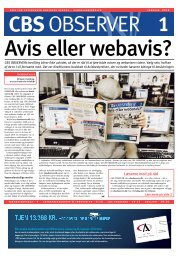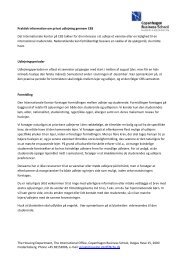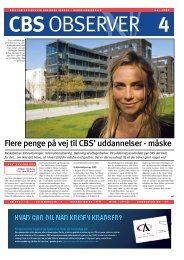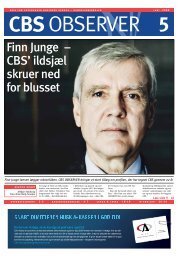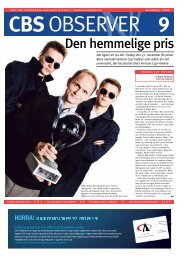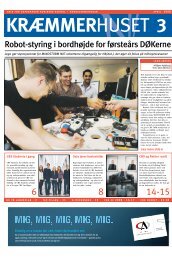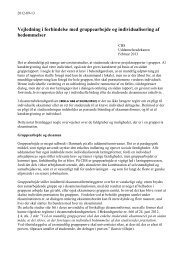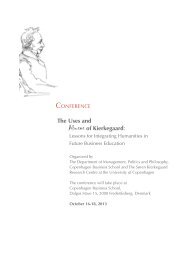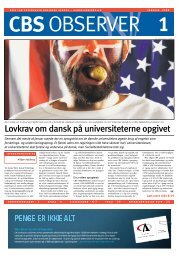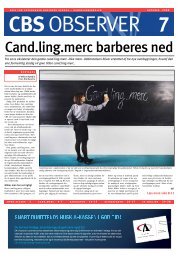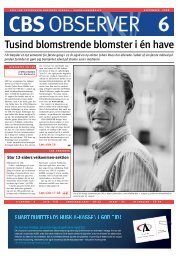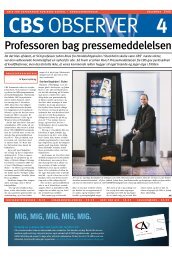Untitled - CBS Observer
Untitled - CBS Observer
Untitled - CBS Observer
You also want an ePaper? Increase the reach of your titles
YUMPU automatically turns print PDFs into web optimized ePapers that Google loves.
Company overview<br />
The history of Toms<br />
Confectionery Group<br />
Two Danish chemists named H. Trojel and V.H Meyer founded<br />
what was to become the Toms Confectionery Group in<br />
1924, when they started producing candy and sweets in humble<br />
settings on the island of Amager, just outside Copenhagen.<br />
They named the company Tom, an acronym for Trojel<br />
Og (and) Meyer. However, the name Tom was easily confused<br />
with the Danish word for “empty”, which is spelled the same<br />
way. Since this turned out to be an unfortunate association for<br />
a company that primarily sold its products through vending<br />
machines, they decided to change the name slightly to Toms.<br />
The development of the company took off after World War<br />
II when local entrepreneur and businessman Victor B. Strand<br />
acquired Toms, which at that point was a small-scale local<br />
chocolate and confectionery producer. Via a range of mergers<br />
and acquisitions in Denmark – most notably those of the<br />
chocolate producer Anthon Berg in 1954 and the confectionery<br />
company Galle & Jessen in 1971 – Strand built a national<br />
chocolate and confectionery powerhouse. In 1950, Toms was<br />
appointed the distinguished title “Purveyor to the royal Danish<br />
court”, which allowed the company to use the image of<br />
the royal crown on its products. In 1961, the company moved<br />
into its new headquarters in Ballerup outside Copenhagen<br />
and combined the majority of its production under one roof.<br />
During the 1990s, Toms expanded its operations abroad<br />
when it tried to gain access to the UK market by acquiring the<br />
candy company Taveners and the chocolate producer Daintee<br />
Chocolate. However, the international venture proved<br />
unsuccessful, and the UK business was divested soon after<br />
Jesper Møller became Toms’ CEO in 2006.<br />
Today, Toms is owned entirely by the Gerda & Victor B.<br />
Strands foundation, which was established in 1974. The ownership<br />
form gives Toms’ management considerable freedom<br />
to focus on the long-term development of the company.<br />
Toms today<br />
Toms is engaged in the development, production and sales of<br />
high-quality chocolate and sugar confectionery products. The<br />
company employs approximately 1,200 people, depending<br />
on the season. Toms is organized in a functional structure,<br />
with central administration at the company headquarters in<br />
Ballerup, Denmark. Most tasks pertaining to the overall strategy<br />
are coordinated from the company headquarters, where<br />
the majority of the administrative employees reside. Production,<br />
on the other hand, is decentralized in five different locations,<br />
with each factory specializing in a different area of<br />
expertise.<br />
Toms’ turnover distribution by market<br />
Foundation ownership<br />
Rule number one in traditional management literature is<br />
that management exists to serve the interests of shareholders.<br />
Foundation ownership, at the very least, stretches that<br />
rule. Foundations primarily seek to ensure the long-term<br />
development of their companies, since foundations have<br />
no shareholders and no dividend requirements. Foundation-owned<br />
companies rely fully on their management and<br />
foundation board members to control the direction of the<br />
company. As a result, many of the traditional corporate governance<br />
models do not apply to foundation ownership. In<br />
addition, foundation-owned companies are entirely protected<br />
against hostile takeover attempts.<br />
The prevalence of the foundation ownership form is a<br />
unique feature of the Danish business environment. Approximately<br />
20 percent of business activity in Denmark is<br />
The Danish market remains Toms’ primary market and the<br />
company generates approximately half of its total revenue<br />
here. With a total market share of approximately 30 percent,<br />
Toms is a clear market leader within the chocolate category<br />
in Denmark. It carries a significant lead over its closest rival,<br />
Mondelez International (the former snack foods division of<br />
Kraft), who controls around 15 percent.<br />
On an international scale, however, Toms is a very small player.<br />
The company ranks around number 50 among the world’s<br />
confectionery companies. Despite this limited international<br />
presence, Toms holds a relatively strong position in the global<br />
travel retail and duty-free segment. Within this niche area, the<br />
company holds a market position as approximately number<br />
seven when measured in volume.<br />
50 % Denmark<br />
15 % Sweden<br />
15 % Germany<br />
10 % Travel retail EU<br />
10 % Exports<br />
1 % Travel retail Far East Asia and Americas<br />
Note: percentages may not total 100 due to rounding<br />
carried out by foundation-owned companies. In fact, many<br />
of the most prominent Danish companies – Lego, Maersk,<br />
Carlsberg, Novo Nordisk and many more – are controlled<br />
by foundations.<br />
The sole purpose of Toms’ owner, the Gerda & Victor B.<br />
Strands foundation, is to ensure the future survival and development<br />
of Toms Confectionery Group in a sound and<br />
profitable manner. As such, the foundation sets no boundaries<br />
on business decisions that live up to this criterion. No<br />
members of the Strand family are active in the foundation<br />
or company today, and the board consists entirely of business<br />
professionals and lawyers. As of 2012, the foundation<br />
has a cash base of approximately 200 million Danish kroner<br />
and, as a result, the Toms Group as a whole is nearly debtfree.<br />
4 <strong>CBS</strong> CASE COMPETITION 2013<br />
5<br />
15%<br />
10%<br />
15%<br />
10%<br />
1%<br />
50%



